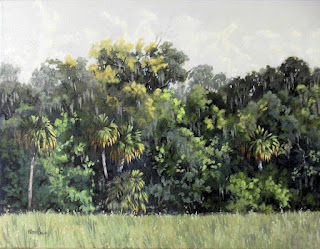Work in Progress
Notes From My Tree Journal
I go back to this five color palette each winter. I really love it. It is a great north Florida palette.
Mars Black (Golden)
Ultramarine Blue (Old Holland)
Yellow Ochre (Old Holland)
Cadmium Red Light (Windsor and Newton)
Titanium White (Golden)
In the spring and summer I add Cad Yellow Lemon and Cad Yellow Medium for truer greens.
I am ever amazed at the variety I can get from the 5 palette. It is really great for plein air work. Any time I begin to lose control of my color mixing, I can go back to this palette and get myself straightened out again.
A reader asked about Pin Oaks.
This is what I found on the web. They do not grow in Florida according to this information:
The Pin Oak tree (Quercus palustris) is also known as the Marsh Oak, althoughthe name of Marsh Oak is a bit misleading. The tree is rarely found in marshes and constantly humid conditions. Nevertheless, flooded river valleys often become home to some of these trees.
Coming from Eastern north America, the tree is a relative newcomer to European lands. It was named Marsh Oak by a German botanist from Hameln called Otto II of Münchhausen, who wrote the first valid description of this tree in 1752. The scientific name Palustris comes from the Latin word meaning "marsh", and its is in the family of Fagaceae (Beech trees).
The original natural home of the Pin oak is the east of the United States of America and of Canada, from Tennessee and Virginia to the areas of the Great Lakes in Canada. http://www.piglette.com/trees/oak/pin.html









